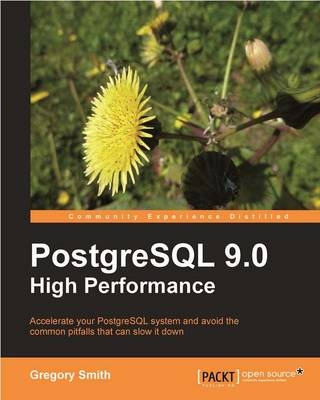
PostgreSQL 9.0 High Performance
Seiten
2010
Packt Publishing Limited (Verlag)
978-1-84951-030-1 (ISBN)
Packt Publishing Limited (Verlag)
978-1-84951-030-1 (ISBN)
Improving database performance requires an equal mix of understanding theoretical concepts and working through hands-on examples. You'll find both here. Many of the examples given will be immediately useful for monitoring and improving your PostgreSQL deployments, providing insight into hard-to-obtain information about your database. This book is aimed at intermediate to advanced database administrators using or planning to use PostgreSQL. Portions will also interest systems administrators looking to build or monitor a PostgreSQL installation, as well as developers interested in advanced database internals that impact application design.
Accelerate your PostgreSQL system
In Detail
PostgreSQL database servers have a common set of problems they encounter as their usage gets heavier and requirements more demanding. You could spend years discovering solutions to them all, step by step as you encounter them. Or you can just look in here.
All successful database applications are destined to eventually run into issues scaling up their performance. Peek into the future of your PostgreSQL database's problems today. Know the warning signs to look for, and how to avoid the most common issues before they even happen.
Surprisingly, most PostgreSQL database applications evolve in the same way: Choose the right hardware. Tune the operating system and server memory use. Optimize queries against the database, with the right indexes. Monitor every layer, from hardware to queries, using some tools that are inside PostgreSQL and others that are external. Using monitoring insight, continuously rework the design and configuration. On reaching the limits of a single server, break things up; connection pooling, caching, partitioning, and replication can all help handle increasing database workloads.
The path to a high performance database system isn't always easy. But it doesn't have to be mysterious with the right guide.
Approach
A clear, step-by-step guide to optimizing and scaling up PostgreSQL database servers. Improving database performance requires an equal mix of understanding theoretical concepts and working through hands-on examples. You'll find both here. Many of the examples given will be immediately useful for monitoring and improving your PostgreSQL deployments, providing insight into hard-to-obtain information about your database.
Accelerate your PostgreSQL system
- Learn the right techniques to obtain optimal PostgreSQL database performance, from initial design to routine maintenance.
- Discover the techniques used to scale successful database installations.
- Avoid the common pitfalls that can slow your system down.
- Filled with advice about what you should be doing; how to build experimental databases to explore performance topics, and then move what you've learned into a production database environment.
- Covers versions 8.1 through 9.0.
In Detail
PostgreSQL database servers have a common set of problems they encounter as their usage gets heavier and requirements more demanding. You could spend years discovering solutions to them all, step by step as you encounter them. Or you can just look in here.
All successful database applications are destined to eventually run into issues scaling up their performance. Peek into the future of your PostgreSQL database's problems today. Know the warning signs to look for, and how to avoid the most common issues before they even happen.
Surprisingly, most PostgreSQL database applications evolve in the same way: Choose the right hardware. Tune the operating system and server memory use. Optimize queries against the database, with the right indexes. Monitor every layer, from hardware to queries, using some tools that are inside PostgreSQL and others that are external. Using monitoring insight, continuously rework the design and configuration. On reaching the limits of a single server, break things up; connection pooling, caching, partitioning, and replication can all help handle increasing database workloads.
The path to a high performance database system isn't always easy. But it doesn't have to be mysterious with the right guide.
Approach
A clear, step-by-step guide to optimizing and scaling up PostgreSQL database servers. Improving database performance requires an equal mix of understanding theoretical concepts and working through hands-on examples. You'll find both here. Many of the examples given will be immediately useful for monitoring and improving your PostgreSQL deployments, providing insight into hard-to-obtain information about your database.
Gregory Smith is the principal consultant in the United States for international PostgreSQL services firm 2ndQuadrant. Based in Baltimore, MD, he's been providing database advice to clients in industries like manufacturing, finance, and web development for twenty years. Dedicated to open-source technology since early in his career, Greg turned to full-time PostgreSQL work by diving in at the source code level. He contributes regular feature patches to the core database and has written a variety of database tools. This book reflects the perspective that he's gained over the last few years as one of the most prolific sources of advice on the popular PostgreSQL community mailing lists.
| Erscheint lt. Verlag | 2.4.2023 |
|---|---|
| Zusatzinfo | black & white illustrations |
| Verlagsort | Birmingham |
| Sprache | englisch |
| Maße | 191 x 235 mm |
| Gewicht | 799 g |
| Themenwelt | Informatik ► Datenbanken ► PostgreSQL |
| Mathematik / Informatik ► Informatik ► Software Entwicklung | |
| ISBN-10 | 1-84951-030-X / 184951030X |
| ISBN-13 | 978-1-84951-030-1 / 9781849510301 |
| Zustand | Neuware |
| Haben Sie eine Frage zum Produkt? |
Mehr entdecken
aus dem Bereich
aus dem Bereich
Praxisbuch für Administratoren und Entwickler
Buch (2018)
Carl Hanser (Verlag)
50,00 €


